
Rosewood History
Tom Kerle of Calvert – A True Bushman
While browsing Ipswich First, the Ipswich City Council’s news and information feed, in June 2020, I read about the Tom Kerle Bridge at Old Red Gum Crossing at Calvert and how its condition was deteriorating. A structural assessment had indicated that continued usage by heavy vehicles could cause further damage to its structure and integrity, so from Monday, 29 June 2020 a permanent 15 tonne gross load limit was imposed on the bridge.
I pondered on the names on the bridge’s sign. They sounded so intriguing, “Red Gum Crossing”…. “Tom Kerle”…. and so Ocker (Australian)!
Then the Ipswich Tribune of 15th July 2022 ran an article about the Tom Kerle Bridge, Hiddenvale Road, Calvert . It would be replaced at a cost of $2.6 million. “Council decided on a full replacement of the four-span 27.6m timber bridge which crosses the Western Creek,” Cr Sheila Ireland said.
I had to go and see it for myself before it disappeared. I read the plaque on the side of the road at the entrance to the bridge, “Red Gum Crossing”. It informs the reader about the old “Forest Red Gum” on the creek bank, which is estimated to be about 463 years old.
I wondered, who was this man Tom Kerle who shared pride of place on the sign with this ancient gum?
With some investigation back at home, it turned out that Tom Kerle was actually named Theodore Kerle.
Theodore “Tom” Kerle was born 6th October 1914 at Marburg to parents Benno Friedrich Kerle (1888-1966), a Farmer at Hidden Vale, and Rosalie nee Zabel (1888-1956). Tom had 6 sisters and 4 brothers. They were Anna Emilie Boughen, Clara Emma Doonan, Harold Kerle, Percy Kerle, Ellen Alma Kerle, Victor Kerle, Vera Edna Kerle, Beryl Ruby Finch, Corinna Marjorie Nicholson and Eric Kerle.
 During his lifetime Tom worked as a Farmer, Bullock Driver, Carpenter, Wheelwight and Labourer.
During his lifetime Tom worked as a Farmer, Bullock Driver, Carpenter, Wheelwight and Labourer.
In his youth he worked on the family farm until he undertook driving bullock drays and carting enormous sized logs around the Grandchester district. He boasted that he had no schooling. Tom was member of the local football club at Grandchester and a member of the Calvert Cricket Club. Like many young men and women, he enjoyed going to the local dances and sometimes won prizes waltzing with his dancing partners, the Monte Carlo being a favourite of Tom’s.
Foxes have always been a menace in rural life. When Tom was 20, several fowls in the area were taken by foxes. A burrow was located on John Ponting’s property. Colin Waters and Tom unearthed three half-grown ones. Their fate, I’ll leave to your imagination.
Tom Kerle (SN B4747) enlisted in the Militia as a Trooper in the 2nd 14th Lightfoot on 10th July 1937, in Brisbane. He was described as being a farmer, 5ft 10ins tall, weight 150lb, brown hair, brown eyes, dark complexion and he had 2 scars on his lower left leg. His religion was Church of England and his next of kin was his mother.
On Monday 9th May 1939, four lads, B. Madden, M. Maroski, G. Lee, and T. Kerle left home for a training camp at Chermside for 12 days.
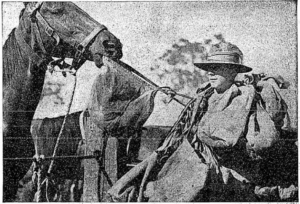
Spider, the horse, was reluctant to part with his feed bag when Trooper Tom Kerle, collecting feed bags, passed
down the horse lines of the 2nd/14th Light Horse Regiment, Beaudesert. (Saturday 10th February, 1940)
Eight months after World War 2 began, on 29th May 1940, Tom Kerle enlisted at Kelvin Grove in the 7 Division Cavalry Regiment for service abroad. He had been examined by Doctor Robert Wallace in Rosewood on 10th and was declared fit to enlist. Tom gave his occupation as a Carpenter and next of kin as Rose Kerle, Calvert.
The following is an account of his service:-
- The 7th carried out its initial armoured vehicle training at Cowra with Vickers light tanks and machine-gun carriers. The regiment embarked per Queen Mary on Boxing Day 1940 from Sydney harbour arriving at Alexandria, Egypt, 1st February 1941. The regiment moved to Helwan, near Cairo then to Palestine, where they continued training. The Division then transferred to the Suez Canal where it helped with the defences, before being sent to the island of Cyprus to support British troops until August, when they were transferred to Syria as part of the garrison force.
- On 4th February 1942 the Division returned to Australia. They embarked per Orcades at Port Said, Eygpt and disembarked 12th March at Adelaide, South Australia, after which they were moved to Landsborough, Queensland.
- From July until September the regiment was sent to the now historic Hangar No. 7 at Eagle Farm to assist with construction work. The hangar, built in 1942, was for the use of the Allied Technical Air Intelligence Unit. Several other hangars were being built and they all needed camouflage paint, and runways had to be constructed. Nearby houses were taken for the war effort and moved onto the site, the owners being minimally compensated. There was much to do.
- The regiment was moved again, this time to Papua New Guinea to help defend Port Moresby, embarking 28th September per Katoomba and reaching Port Moresby on 7th October. The Australian soldiers had been fighting fiercely along the Kokoda Trail since July, and in terrible terrain. Casualties were heavy, and towards the end of the year they were able to push the Japanese back to their bases at Buna, Sanananda and Gona.
- From Port Moresby, they were then flown to Poppendetta to reinforce the Australians who were there. On 18th December they moved up to Huggins Road Block and went on to take part in the bitter fighting along the Sanananda Track and village. It wasn’t until 21st January 1943, that they were successful. After the battle only about fifty fit men remained with the regiment. 54 had been killed including Lieutenant Colonel Edgar Logan, one died of wounds, 67 were wounded, 3 died from scrub typhus and 240 were sick with malaria.
Unfortunately, Tom was one of these men with malaria, and it would plague him throughout the coming years. He was evacuated to 2/9th Australian General Hospital in Adelaide. Then in February he returned to his unit which was slowly reforming on the Atherton Tableland in Queensland. By April he was sent to 112 General Military Hospital at Greenslopes in Brisbane with malaria and an injury to his ankle, and then transferred to 101 Convalescent Depot at Coorparoo. There were about 300 inmates at the hospital and about 1,100 to 1,200 soldiers passing through this Convalescent Depot each month.
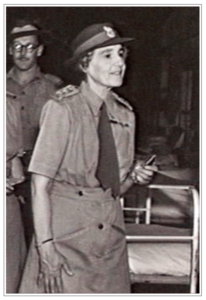 He was discharged on the 18th June to rejoin his unit and 6 days later he was back in hospital in 2/14 Australian General Hospital, Townsville, with another bout of malaria. While he was there, Lady Zara Gowrie, wife of the Governor General of Australia, visited the hospital as part of her tour of Queensland. She held the rank of Colonel in the A.W.A.S.. Lady Gowrie broke away from the official party to talk to four of the patients whom appeared to be working on a project. One of them was Tpr. Tom Kerle. The others were Gnr. Henry Desjardins, of Grandchester, Pte. Arthur William Hosford, Parramatta, Sydney and Gnr. Stewart Heaney, Torrens Park, Adelaide.
He was discharged on the 18th June to rejoin his unit and 6 days later he was back in hospital in 2/14 Australian General Hospital, Townsville, with another bout of malaria. While he was there, Lady Zara Gowrie, wife of the Governor General of Australia, visited the hospital as part of her tour of Queensland. She held the rank of Colonel in the A.W.A.S.. Lady Gowrie broke away from the official party to talk to four of the patients whom appeared to be working on a project. One of them was Tpr. Tom Kerle. The others were Gnr. Henry Desjardins, of Grandchester, Pte. Arthur William Hosford, Parramatta, Sydney and Gnr. Stewart Heaney, Torrens Park, Adelaide.
The four men left their carpenter’s work bench and introduced their “foreman,” Sister J. McKenzie, of Lakemba, Sydney.
“I hope Sister doesn’t make you work too hard,” Lady Gowrie laughed.
“Not at all,” Tom Kerle answered. “She handles all the hard work! We just have to do what she tells us!”
Tom explained that when he and his pals were members of separate wards, rivalry between them was keen. When they were moved to the same ward they organised “scrounging” expeditions, searching a nearby beach for timber from which they made linen presses, crockery cupboards, medicine chests, and furniture. A canvas tent fly, stretched over a pole, was their headquarters. They recruited Sister Bettie Garood, of Adelaide, and appointed her “nail-straightener-in-chief.” The men displayed great initiative. Unable to obtain a priority for the purchase of tools, they made a plane from a piece of hardwood, with a filed-down car spring as a blade. Their hammers were improvised and their only saw was one found washed up on the beach.
After Lady Gowrie had gone, the men had one regret. “We forgot to ask her if she could do anything about getting tools and materials for us,” they said.
Henry Desjardins (“Nails”) and Tom Kerle (“Chips”), both fought in the Middle East and were evacuated sick from New Guinea and knew each other before enlisting. “Nails” was a farmer, and “Chips” a bullock driver in the Grandchester district. Stewart Heaney, formerly a ship’s carpenter, was known as “Shavings,” and Arthur Hosford, who was also in the action at Sanananda in the attacks which drove the Japanese from that area in late 1942, answered to “Sawdust.”
Like most soldiers, they had a “Pin-up Girl,” intended, they said with a laugh, “to make the sisters jealous,” Their “girl” was a playing card-the Queen of Hearts. (1)- On 5th November 1943, Tom Kerle was discharged to 13 Australian Army Personnel Staging Camp at Toowoomba, where he was deemed medically fit to carry out certain duties which require restricted medical fitness. It was then that Tom Kerle became a cook and then a boiler attendant.
- Tom was sent to 7 Australian Advanced Ammunition Depot, Baronta, on the Atherton Tablelands. He was promoted to acting Corporal on 24th December and by 30th and was back in hospital at 116 Australian General Hospital in Charters Towers. He was discharged 10th January 1944 and went back to Baronta.
- In March Tom was granted 24 days leave and on 12th May his rank of Corporal was confirmed.
- In October, Tom found himself in the 5th Australian Camp Hospital at Rocky Creek, Atherton Tablelands suffering from Hypertension. He was sent back to the hospital in Townsville until March 1945, when he was discharged back to Toowoomba.
- The Japanese Emperor, Hirohito, gave a recorded radio address across the Empire on 15th August. In the radio address he announced the surrender of Japan to the Allies.
- On 27th Aug 1945, Tom Kerle embarked with other troops per Duntroon at Sydney for Singapore. They were sent to asssit in preparations for the formal Japanese surrender ceremony and the liberation of the thousands of POWs on the island.
- The War officially ended on 2nd September but the formal surrender instrument wasn’t signed until 12th September at the Singapore Municipal Building. It was followed by a celebration at the Padang (open playing field), which included a victory parade. Tom would have been there to witness this.
- As fate would have it, Tom was accidentally injured on 25th September when he inhaled sternutator gas. He left Singapore per HMT Cheshire on 2nd November and arrived at Sydney on 23rd. He was sent to the Recruit, Reception and General Details Depot at Wacol for discharge on 14th December 1945.
- Altogether Tom served 2026 days fulltime war service, 1117 in Australia and 669 overseas.
When Tom returned home to Calvert, no doubt, like thousands of other soldiers, he adjusted as best he could to civilian life in his own good time. A welcome home ceremony was held in Grandchester in July 1946 for 46 returned service men and women. Tom and the other men were each presented with a gift of a tobacco pouch, a sum of money, a notecase and a certificate, by E. B. Maher M.L.A..
By 1951 Tom was involved in community life. He was part of the group of men who worked towards getting a recreation hall in town. A meeting of the Calvert Recreation Hall Committee was held in the Calvert school on 28th June when Tom was elected as the secretary. The other members were: President, Mr. J. W. Lee; vice-president. Mr. G. Mann; treasurer, Mr. K. Allen; auditor, Mr. J. Reid; committee, Messrs. A. Campbell, G. Osland and T. Wilkie. The Hall was finally opened in early December 1953 and, at the event, Mr Lee particularly thanked Tom Kerle for his large donation of timber  to help complete the hall.
to help complete the hall.
In February 1954, Tom was working with Murdo McKenzie dipping Murdo’s cattle on his property at Old Hidden Vale Station. A Zebu bull charged Murdo, striking him with its horns. His face was badly cut and bruised but no severe injuries were afflicted thanks to Tom, who dragged him to safety.
Tom Kerle died 10th September 1990, in Ipswich, just shy of his 76th birthday. He was interred at the Warrill Park Lawn Cemetery, Cassisa Avenue Section 2, Row 44.
Tom apparently possessed a sharp tongue and a heart of gold. And it was said that he never let a friend down. He could not abide “so called experts” telling him how to do his work. His carpentry and wheelwright work, though self taught, was skillfull and well performed. He only used a make-shift sheet of tin with spoke and wheel markings as a guide, yet his work was faultless and made to last. Along with an old rolling machine, lathe, firing area and cooling pit, Tom crafted his wheels in his huge self-built shed. Outside of his shed he had a sign which displayed his dry wit. “We shoot every third agent. The second one just left.” Cleary he had no time for opportunistic time-wasters. He crafted sulkies and gigs and bullock wagons and many impressive 7 metre long, rawhide whips.
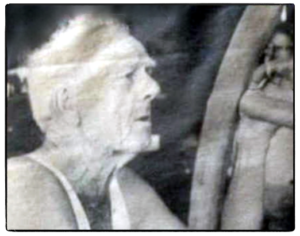 Tom lived a humble life. He chose not to have electicity connected to his property when it was connected to the town around 1946. His appliances were an old wood stove and kerosene fridge, having made all of his furniture himself. His bathtub was located outside. Tom was convinced that human beings had become far too lazy and that money lay at the root of much of the strife in the world.
Tom lived a humble life. He chose not to have electicity connected to his property when it was connected to the town around 1946. His appliances were an old wood stove and kerosene fridge, having made all of his furniture himself. His bathtub was located outside. Tom was convinced that human beings had become far too lazy and that money lay at the root of much of the strife in the world.
In an interview he gave before he died, Tom said, “Contentment is everything, not money. I’ve walked away from dozens of good jobs because I wasn’t happy with the bastards I had to work with. You don’t see things in life in an office watching the clock. I’ve learnt more about life sitting on my verandah looking at what happens outside my front door and reading my books.”
It’s safe to say that Tom and I are alike in some ways.
Like that ancient Red Gum tree, Tom Kerle was part of the living history of the Calvert area, both solitary figures standing strong amongst the rest, well grounded, living by their own terms, weathering whatever life threw their way and observing the development of the district.
I can see why Tom’s name belongs on that sign at the bridge.
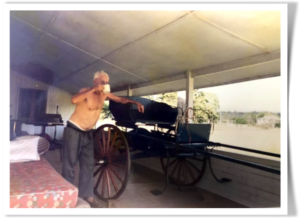
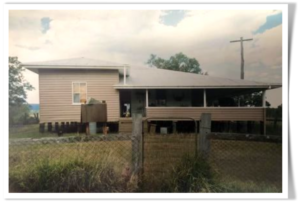
Photos kindly provided by Wayne Kurtz .
Wayne lived across the road from Tom Kerle in Gipps Street, Calvert and spent a lot of time with him as a child, plaiting whips or sitting on Tom’s veranda talking.
© Jane Schy, 2024
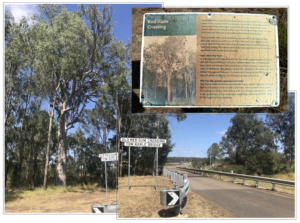
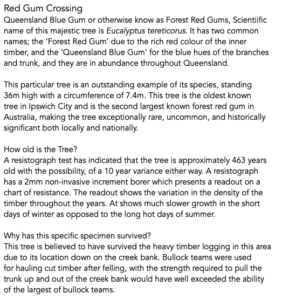
Sources:
(1) Queensland Times (Ipswich, Qld. : 1909 – 1954), Monday 8 November 1943, page 4
Queensland Registry Births, Deaths & Marriages
Trove – National Libary Australia
National Archives Australia
